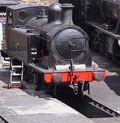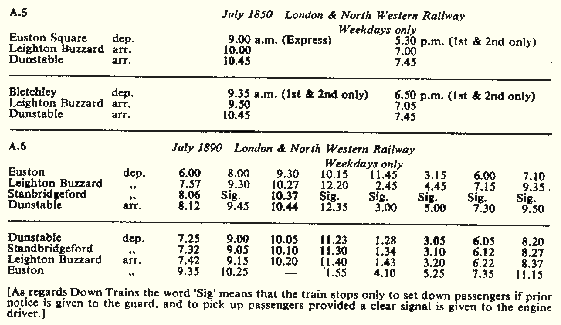|
 |
 |
 |
 |
 |
 |
 |
 |
 |
 |
 |
 |
 |
 |
 |
 |
 |
 |
 |
 |
 |
|
|
|
|
|
|
London And North Western Railway 1846-1923
|
|
|
|
|
|
|
|
|
 |
|
Dunstable Branch |
|
|
|
|
|
|
|
|
|
|
|
|
 |
|
|
|
|
 |
|
|
|
|
|
|
|
|
 |
|
|
|
Railway map of 1848 |
|
|
|
|
|
|
|
|
|
|
|
|
 |
|
The bill for the London & Birmingham & Dunstable Railway was successful and became an Act on June 30th 1845. By this time the L&BR had become the L&NWR but this company continued to support the branch line. However a change was made to the planned route. The L&BR plan included a gradient of 1 in 27 for just under a mile of the track which made it unsuitable for steam engine operation. The L&NWR modified this gradient to just over a mile at a stiff but more agreeable incline of 1 in 40 |
|
 |
|
|
|
 |
The Leighton Buzzard to Dunstable 6 and 3/4 mile branch line was engineered by George Stephenson and opened for goods on May 29th and for passengers on June 1st 1848. |
|
|
|
|
 |
|
|
|
George Stephenson |
|
|
|
|
|
|
|
|
|
 |
|
|
The Branch Line was much needed to take the heavy (30,000 tons a year) coal traffic and return with chalk. In all probability those early passenger trains would be green and black 4 wheel carriages pulled/pushed by a Bury Engine. |
|
|
 |
|
Engines and Timetables |
|
|
|
|
|
|
|
|
|
|
|
 |
|
When the Branch line opened the engines used were little bar-framed Bury 0-4-0 and 2-4-0 engines with 5 ft 9 in wheels but these found it very hard work due to the gradients on the line. Two engines were specially built to run on the line with 4ft driving wheels and were 0-4-0 type engines. Later on Allen 2-4-0 goods engines were converted into tank engines for branch line service. Two of these, "Gorgon" and "Giant", were working the Dunstable Branch in 1873. The usual passenger trains consisted of three carriages. In 1892 another 2-4-0 tank no.1191 came on the line and the train increased to five carriages. |
|
|
|
 |
|
|
|
|
 |
|
|
|
|
|
|
|
|
|
|
|
 |
|
|
|
|
|
This is an 0-6-2 Tank engine similar in design to the tank engines that would have run on the branch line |
|
|
|
|
|
 |
|
|
|
The branch line proved to be so popular that by 1900 there were 7 trains in each direction on it. However there was no Sunday service because of a restriction by a landowner over whose land much of the branch ran. |
|
 |
|
 |
 |
|
|
|
|
|
The above are the timetables for July 1850 and July 1890 showing the increase in trains between those dates. |
|
|
|
|
|
|
|
 |
 |
|
|
|
|
|
|
|
|
|
 |





